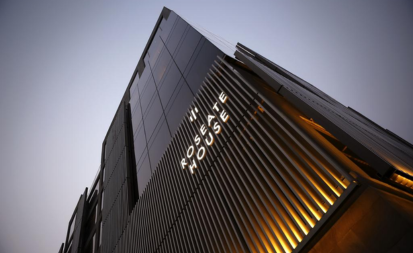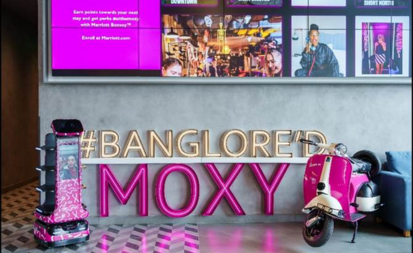Wineries and Tourism Boards have been Actively Promoting Wine Tourism in India
Gaurab Dey, Director of Food and Beverages, The Westin Mumbai Powai Lake Major factors behind the growth of Wine tourism in India Wine tourism in India has been on the rise in recent years, and several factors

Gaurab Dey, Director of Food and Beverages, The Westin Mumbai Powai Lake
Major factors behind the growth of Wine tourism in India
Wine tourism in India has been on the rise in recent years, and several factors have contributed to its growth. While India may not be as well-known for wine production as countries like France or Italy, it has seen significant developments in its wine industry, leading to increased interest in wine tourism. Here are some major factors behind the growth of wine tourism in India:
· Emerging Wine Industry: India’s wine industry has been steadily growing, with an increasing number of wineries and vineyards across the country. This growth has led to a greater availability of high-quality, locally-produced wines, which is a key driver for wine tourism.
· Scenic Vineyard Locations: Many Indian wineries are located in picturesque settings, such as Nashik in Maharashtra, the Nandi Hills in Karnataka, and the hills of Himachal Pradesh. These scenic vineyard locations attract tourists looking for a relaxing and visually appealing getaway.
· Cultural and Culinary Experiences: Wine tourism often goes hand in hand with culinary experiences. Many wineries in India offer tours and tastings paired with delicious local cuisine. Visitors can enjoy wine with traditional Indian dishes, creating a unique and enjoyable fusion of flavors.
· Wine Festivals and Events: Wine festivals and events have gained popularity in India, offering visitors the chance to sample a variety of wines and enjoy entertainment and cultural activities. These events help promote wine culture and attract tourists.
· Marketing and Promotion: Wineries and tourism boards have been actively promoting wine tourism in India through marketing campaigns and partnerships with travel agencies. These efforts have helped raise awareness and attract more tourists.
· Government Support: In some cases, state governments have provided support to the wine industry through incentives and favorable policies, which have encouraged the growth of vineyards and wineries.
Overall, the growth of wine tourism in India can be attributed to a combination of factors, including the development of the wine industry, the appeal of scenic vineyard locations, cultural and culinary experiences, and increasing interest in wine culture among both domestic and international tourists.
How has the placement/ demand of wine in Hotels changed over time?
The placement and demand for wine in hotels have evolved significantly over time, reflecting changing consumer preferences, trends in the hospitality industry, and developments in the wine market. Here are some key changes in the placement and demand for wine in hotels:
Wine Lists and Offerings:
· Expanding Wine Lists: Hotels have increasingly expanded their wine lists to offer a wider variety of wines from different regions and price points. This caters to diverse consumer preferences and provides a more extensive selection.
· Local and Regional Focus: Many hotels now focus on featuring local and regional wines, emphasizing the importance of terroir and supporting nearby wineries. This trend aligns with the locavore movement.
Wine by the Glass:
· By-the-Glass Options: Hotels now offer a wider selection of wines available by the glass, allowing guests to try different wines without committing to a full bottle. This promotes wine exploration and caters to varying preferences.
Sustainability and Organic Wines:
· Emphasis on Sustainability: Many hotels have incorporated sustainability into their wine programs by offering organic, biodynamic, or sustainably produced wines. This aligns with the growing interest in environmentally friendly practices.
Cultural and Thematic Integration:
· Cultural Themes: In some cases, hotels integrate wine into their overall theme or ambiance, such as offering wines that align with the cuisine of a particular region or culture.
Marketing and Branding:
· Branded Wine Programs: Some hotels have developed their own branded wine labels or partnerships with wineries, creating exclusive wines for their guests.
Consumer Education:
Many hotels have invested in staff training to enhance their wine knowledge, enabling them to better assist guests with wine selections and recommendations.
The placement and demand for wine in hotels have evolved to meet changing consumer preferences and market dynamics. Hotels have diversified their wine offerings, improved storage conditions, integrated technology, and focused on sustainability and customization to enhance the overall guest experience. The wine culture in hotels continues to evolve, reflecting broader trends in the wine industry and the evolving tastes of their patrons.
Wine has become an essential part of the menu in today’s dining experience. What are the key factors in managing and serving the diners’ wine options?
Managing and serving wine effectively is indeed crucial to enhancing the dining experience for guests. Here are key factors to consider when managing and serving diners’ wine options:
Wine Selection and Variety:
· Diverse Wine List: Offer a well-curated and diverse wine list that includes wines from different regions, grape varieties, and price points. Ensure there are options to suit various tastes and budgets.
Wine Storage and Temperature Control:
· Proper Storage: Maintain a well-organized wine storage area with appropriate temperature and humidity control to preserve the quality of the wines.
· Temperature Service: Serve wine at the correct temperature (e.g., red wines slightly below room temperature, white wines chilled) to enhance the flavors and aromas.
Wine Presentation:
· Clean Glassware: Ensure wine glasses are clean and free of residue or odors that can affect the wine’s taste.
· Correct Glassware: Use appropriate glassware for different wine types, such as Bordeaux glasses for red wines and smaller glasses for white wines.
Wine Service and Training:
· Knowledgeable Staff: Train your staff, including servers and sommeliers, in wine knowledge and service techniques. They should be able to assist diners with wine selection, answer questions, and provide recommendations.
· Opening and Pouring: Teach proper wine bottle opening and pouring techniques to ensure a smooth and elegant presentation.
· Wine Tasting: Offer diners a small taste of the wine before pouring a full glass to ensure it meets their expectations.
Wine Preservation:
· Wine Preservation Systems: Use wine preservation systems, such as nitrogen or argon gas, to keep open bottles of wine fresh for longer periods. This reduces waste and allows for more wine-by-the-glass options.
· Re-corking: Offer to re-cork unfinished bottles for guests who wish to take wine home.
Pricing and Value:
· Transparent Pricing: Clearly display wine prices on the menu to avoid surprises for diners. Consider offering a range of price points to accommodate different budgets.
· Wine Value: Offer wines that provide good value for their quality, and educate diners about the relative value of the selections.
Wine Accompaniments:
· Wine Accessories: Provide wine accessories such as corkscrews, decanters, and wine chillers to enhance the wine service experience.
Legal Compliance:
· Licensing and Regulations: Ensure that your establishment complies with all local laws and regulations related to the sale and service of alcohol.
By paying attention to these key factors, restaurants and dining establishments can effectively manage and serve diners’ wine options, creating a memorable and enjoyable wine experience that complements the overall dining experience.
According to you, how has the wine industry evolved over time in terms of supply as well as customer demand? How has it been impactful for your brand?
Evolution of the Wine Industry:
The wine industry has seen significant global expansion, with wine production occurring in regions beyond traditional wine-producing countries. New World wine regions, such as those in the United States, Australia, and South America, have gained prominence. Winemaking techniques have evolved with the adoption of modern technology, leading to improved wine quality and consistency. There’s a growing emphasis on sustainability and organic practices in vineyards and wineries, reflecting consumer demand for eco-friendly and ethically produced wines. The industry has diversified in terms of grape varieties, styles, and winemaking methods, offering consumers a wider range of choices.
Customer Demand:
· Diversification of Tastes: Consumers have become more adventurous and open to exploring a variety of wines, including those from lesser-known regions and grape varieties.
· Health and Wellness: There is a growing interest in the potential health benefits of moderate wine consumption, such as the antioxidants found in red wine.
· Wine Education: Consumers are increasingly interested in wine education, wanting to understand wine regions, terroir, and food pairings.
· E-Commerce: Online wine sales and wine clubs have become popular, providing consumers with convenient access to a wide range of wines.
· Social and Cultural Factors: Wine has become a part of social gatherings and cultural experiences, contributing to its continued popularity.
Impact on Wine Brands:
The evolution of the wine industry in terms of supply and customer demand can have several impacts on wine brands:
· Product Innovation: Brands may need to innovate and adapt to changing consumer preferences by introducing new wine styles, packaging, or marketing strategies.
· Marketing and Branding: Effective branding and marketing campaigns that align with current consumer trends and values can help wine brands stand out in a competitive market.
· Sustainability: Brands that embrace sustainable practices can attract environmentally conscious consumers and enhance their brand reputation.
· Diversification: Offering a diverse range of wines can appeal to a broader customer base and accommodate changing tastes.
· Education: Brands that provide educational resources and experiences, such as tastings and wine tours, can build loyalty and trust among consumers.
· E-Commerce Presence: Establishing a strong online presence and e-commerce platform can expand a brand’s reach and accessibility to customers.
· Adaptation to Regulations: Staying informed about evolving regulations related to wine production, labeling, and distribution is essential for compliance and consumer trust.
It’s important to note that the wine industry is dynamic, and consumer preferences can change rapidly. Staying attuned to these changes and adapting accordingly is crucial for wine brands to thrive in the evolving market.
How is wine at your brand (Hotel, restaurant or airline) playing an essential role in customer experience?
wine can play an essential role in enhancing the customer experience for such businesses. It enhances the flavors of our dishes, providing a harmonious and complete dining experience.
· Complementing Culinary Offerings:
Wine can be carefully selected to complement the restaurant’s or hotel’s culinary offerings. Pairing the right wine with dishes enhances the flavors and elevates the dining experience.
· Diverse Wine Lists:
Offering a diverse and well-curated wine list provides customers with choices that cater to different tastes and preferences. This variety can enhance the overall dining experience.
· Expert Wine Recommendations:
Employing trained sommeliers or knowledgeable staff who can provide expert wine recommendations adds value to the customer experience. These professionals can guide diners in selecting wines that enhance their meals.
· Wine by the Glass:
Providing a selection of wines available by the glass allows customers to explore different wines and flavors, even when dining alone or in smaller groups.
· Wine Pairing Menus:
Restaurants and hotels can offer wine-pairing menus, where each course is expertly paired with a specific wine. This creates a cohesive and memorable dining experience.
· Exclusive Wine Labels:
Some establishments collaborate with wineries to create exclusive wine labels or house wines, offering unique options that cannot be found elsewhere.
· Wine Storage and Presentation:
Proper wine storage and presentation, including the use of appropriate glassware and decanters, contribute to the overall ambiance and sophistication of the dining experience.
· Wine in Hotel Rooms:
Hotels can enhance the guest experience by offering wine in guest rooms or suites as part of a welcome amenity or room service. This adds a touch of luxury and convenience.
· Airline Wine Selections:
Airlines can improve the in-flight experience by offering a thoughtful selection of wines. High-quality wines served at the appropriate temperature can make a long journey more enjoyable.
whether in a hotel, restaurant, or airline, wine can significantly impact the customer experience by adding sophistication, diversity, and an extra layer of enjoyment to the overall offering. Thoughtful wine selection, service, and education can elevate the customer experience and contribute to customer satisfaction and loyalty.
 English
English French
French German
German Italian
Italian




